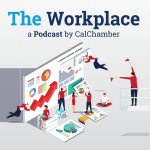
With open enrollment just around the corner, employers may be wondering what types of benefits to offer their employees besides the traditional health and dental options.
In Episode 31 of The Workplace, CalChamber Executive Vice President and General Counsel Erika Frank and employee benefits expert Vinny Catalano discuss trends in employee benefits that are low in cost to employers, but high in value to employees.
Benefit Trends
Finding an employee benefits program that works for everyone can be challenging given that the U.S. workforce is highly diverse, with as many as five generations working at the same time, Catalano, senior vice president of Gallagher Benefit Services, tells Frank.
Previously, the trend in employee benefits focused on employee “wellness” in order to lower costs, he says. That concept has now changed to a focus on holistic “well-being.”
“Organizations have always struggled with using the wellness vehicle as a way to curtail health care costs,” Catalano explains. “Now, that has evolved into the word ‘well-being’ and so well-being now not just applies to physical well-being, we’re talking about emotional well-being, career well-being, financial well-being. So we’re trying to look at employees now for a more holistic perspective because younger generations are worried about their financial health.”
For example, concerning career well-being, people nowadays want to see a path to success, Catalano says. To keep people around longer, employers should show their employees a path to long-term growth within the company, showing them a future they can work toward.
People also want to be educated, Catalano tells Frank. Investing in a continuing education credit, e-learning courses or workforce development training is another benefit that would be low-cost, but is of high value to an employee.
Additionally, providing mental health resources, like employee assistance programs, is a great way for employers to provide support for their workers’ mental and physical well-being.
“If you are providing an employer-paid life and long-term disability program, that insurance carrier will provide a free EAP [Employee Assistance Program] along with that,” says Catalano. “…At the end of the day, people want to know they have resources to help them access mental health and other areas of their life.”
Show Benefit Investments to Employees
In order for employees to get the most out of their benefits, it is important for employers to develop a strategy to inform employees about all that is offered.
“One of the areas that we work with employers on is developing…an internal marketing communication strategy to help,” says Catalano. “An open enrollment meeting is one thing, but what are we doing all year around to engage the employees on all the factors of well-being? How are we training them to be mindful of their financial health? How are we training them to be mindful of their mental health?”
Frank recommends that just as many employers send out wellness communications — such as “Did you get your steps in?” — employers also should send out reminders such as “Did you look at your 401k?” or “Are you aware of our EAP program?”
Nice to Have vs. Have to Have
Engaging in an open conversation with employees about what benefits they need or want may bring surprising answers. According to an annual study by MetLife, what employers think is important is different from what employees think is important when it comes to benefits, Catalano says.
“You have to tap into…the culture of your organization, what benefits are going to resonate with employees, but most importantly, frankly, how do we get people understanding what it is they have?” Catalano explains.
There are many benefits employers can choose from, but no matter what they pick, the employee’s needle is going to move only if benefits are well-communicated, Catalano stresses.
Previously on The Workplace
In a previous episode of The Workplace (No. 27), Catalano discussed with Frank how employers can best prepare for open enrollment season to both prioritize the well-being of their employees and stay within their budgets.
Catalano suggests that employers outline a comprehensive strategy ahead of time in order to mitigate potentially uncomfortable decisions over which benefits plans to pursue.
Employers should also communicate the price they are paying for their employees’ benefits, Catalano advises, by presenting benefit statements so that employees can see their complete annual reward packages.
Combined with pursuing programs that address the needs of their employees, these steps can help employers build loyalty and navigate the stresses of open enrollment season, Catalano says.
Subscribe to The Workplace
Subscribe to The Workplace on iTunes, Google Play, Stitcher, PodBean and Tune In. New episodes are released each Wednesday.
To listen or subscribe, visit www.calchamber.com/theworkplace.

